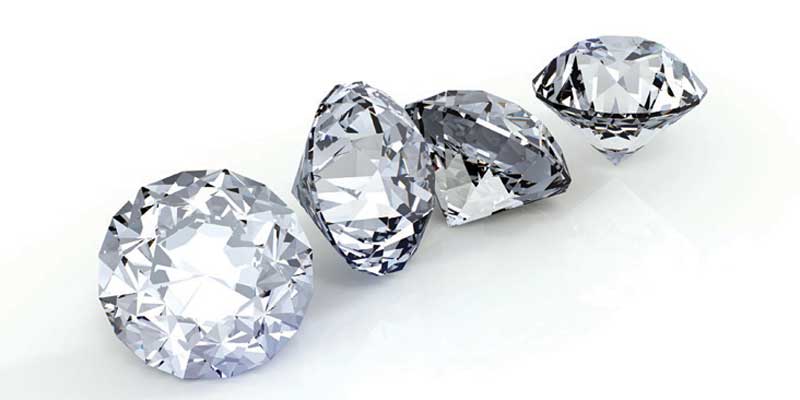Crystal clear: What does diamond branding really say?
by Jason_cramp | August 8, 2017 10:50 am
By Melvin Moss
 [1]There’s a lot to say about the power of branding. The Polar Bear Diamond was among the first wave of branded diamonds. De Beers had just discontinued its Diamond Promotion Service (DPS), so the timing was opportune. The Polar Bear brand relied on Canadian origin as its primary differentiator; juxtaposing Canada’s pristine image to that of blood and conflict in Africa. The idea of branding a diamond, from the very beginning, is founded in the promotion of one diamond at the expense of others.
[1]There’s a lot to say about the power of branding. The Polar Bear Diamond was among the first wave of branded diamonds. De Beers had just discontinued its Diamond Promotion Service (DPS), so the timing was opportune. The Polar Bear brand relied on Canadian origin as its primary differentiator; juxtaposing Canada’s pristine image to that of blood and conflict in Africa. The idea of branding a diamond, from the very beginning, is founded in the promotion of one diamond at the expense of others.
Ten years ago, I wrote an article for Jewellery Business called “Mark…my words.” My contention then was “too many industry initiatives can effect more confusion than benefit.”
So, what has transpired since?
Ten years later
The Polar Bear brand is gone. De Beers’ Supplier of Choice (SoC) program failed and morphed into Forevermark.
Today, De Beers is expanding into every level of the diamond pipeline including mining, manufacturing, wholesale, retail, and grading. The World Federation of Diamond Bourses (WFDB) is promoting the World Diamond Mark, a retail-based ethical incentive. Major diamond miners formed The Diamond Producers Association (DPA), which is tasked with promoting generic diamonds. The Kimberley Process (KP) is being harshly criticized by industry and non-governmental organizations (NGOs), and is trying to be relevant in an increasingly transparent world.
 [2]
[2]The Responsible Jewellery Council (RJC) has a membership based mainly in mining and manufacturing resulting in minimal impact on retail practices. The Israeli Diamond Exchange (ISDE) is expanding into online sales and is assisting Israeli diamond manufacturers in selling directly to the public.
The CanadaMark origin program continues with modest success. CanadaMark is attempting to gain more recognition by giving an exclusive online presence to e-retailer James Allen.
Rapaport is involved in everything from investment diamond schemes to politics. Local jewellery organizations are somewhat irrelevant. The Canadian Diamond Code of Conduct (CDCC) is teetering on the brink of extinction. Diamond grading scandals abound and retailers are realizing how dangerous it is to promote grading brands in place of their own knowledge.
Brand power
The purpose of initiating any branding program is to differentiate a product with the specific intent of increasing sales. I want to stress when I speak about diamond branding and differentiation, I am not referring in any way to jewellery brands. A jewellery brand is defined by the use of different gemstones, metals, fashion, and artistic expression, whereas a diamond is simply a diamond.
When BHP Billiton created the CanadaMark origin program, it instituted a condition stating no authorized vendors could promote CanadaMark with any negative references to generic diamonds.
Today, under Dominion Diamond Corporation, standards have changed. The CanadaMark origin brand can be found publicized in contrast to scenes of third-world mining abuse and atrocities—I use the term brand with reference to CanadaMark because when Dominion Diamond decided to remove exclusive vendor licensing from their chain of custody, their CanadaMark origin card became another brand.
Origin-based brands i.e. CanadaMark, those supported by a proposed superior diamond report i.e. Forevermark, investment quality brands i.e. Rapaport Investment Diamond Certificate, or brands bases upon retailers’ ethics i.e.World Diamond Mark can all be viewed as diminishing the appeal for diamonds as a category.
Take Newton’s Third Law as the example, “For every action, there is an equal and opposite reaction.” Translated into diamond terminology, a positive reason for buying a specific branded diamond suggests an equal and opposite reason for not buying any other diamond.
De Beers sells Forevermark diamonds as traceable and more ethical than the generic diamonds they supply to non-Forevermark sightholders. De Beers’ Forevermark claims one cut from the same parcel of rough diamonds is somehow superior to a second cut. Chaim Zohar, president of Diamonds Intelligence Briefs, points out De Beers efforts to add value to their diamonds are not profitable: “Maybe the time has arrived for Anglo American (De Beers) to review these downstream activities that were developed over a period of well over a decade and that represent a drain on its cash and profits,” says Zohar. “None of these activities, as far as is known, have delivered a profit to the company yet, and the costs and investments are huge.”
Initiatives like De Beers retail stores and Forevermark are simply not making any more profit after expenses than if De Beers remained exclusively in mining and rough distribution.
Unity matters
DPA’s ‘Real is rare,’ campaign slogan connotes a positive message. All major diamond miners makeup the membership of this association. De Beers brands Forevermark diamonds, Rio Tinto has Australian diamonds, Dominion Diamond brands CanadaMark, and Alrosa will soon be marketing Russian diamonds. The mission of the DPA is to promote all diamonds, and yet the core members see no conflict with their privately branded diamonds.
The fundamental reasons for purchasing a diamond are emotional. Branding them is unnatural because all diamonds are simply one element—carbon. Branding watches and jewellery is a natural progression because of the attributes of function and design. The idea of branding a diamond is based on the false pretence that one diamond is better than another, even when each have the same physical characteristics. Some branded diamonds make it seem almost reprehensible to buy any other. Brands present consumers with a multitude of reasons to question the purchase of any diamond. At the present time, diamonds are competing with themselves and if they succeed, they will defeat themselves.
The Gemological Institute of America (GIA) and The International Institute of Diamond Grading and Research (IIDGR) established by De Beers are brands fighting for monopoly of diamond grading reports. De Beers’ laboratory currently grade all Forevermark diamonds with the claim of grading to a superior ethical and empirical standard. The GIA, in order to compete, has countered by announcing a multitude of new initiatives including a new diamond origin tracking service. This war is in its initial stages. Retailers and consumers will be the collateral damage as they get caught in the branding cross fire. As the African proverb says, “When two elephants fight, it is the grass that gets trampled.”
Retailers already need to explain the artificial difference between a branded diamond and a generic diamond. Soon, they will need to justify differing claims made by competing branded diamond grading reports. Logic concludes one universal diamond grading standard would be most beneficial, but these mega-brands are more interested in profit.
Diamonds are not a liquid investment. The new Rapaport Investment DiamondReport is designed to promote diamond investment portfolios. Diamonds will never be a properly regulated straightforward investment opportunity.
There are too many subjective elements and too many hands in the pot. Investment diamond schemes have done nothing but damage diamond credibility. Investors sooner or later discover diamonds cannot be resold easily and certainly not with real investment returns. These schemes always fail and leave a trail of damage to be cleaned up by those who legitimately buy and sell diamonds for use in jewellery.
Diamonds are a luxury product. No other luxury product is attempting to become a commodity that can be traded on world stock exchanges. In fact, commodity trading is the antithesis of luxury.
Consumers pay a high price for luxury and price is based on product desirability. The price of luxury rises and falls based upon industries’ ability to work together to elevate the image of the product.
The diamond industry is reacting to the disruptive forces changing traditional business. However, the diamond industry is not reacting well. Diamond-related initiatives are dwelling on distractions and negativity rather than collectively contributing to the elevation of all diamonds.
The reason the slogan ‘A Diamond is Forever’ works is because it has an inclusive positive message. The comparison of all diamonds to enduring love is brilliant. In contrast, pitting diamonds against one another detracts from the essential message that all diamonds are desirable.
All views and opinions expressed in this column are solely of Melvin Moss of Regal Imports Ltd., and do not necessarily reflect those of Jewellery Business or Kenilworth Media Inc.
 [3]Melvin Moss is a long-time diamond supplier and the owner and president of Regal Imports. He is a diamond industry activist and produces a monthly state-of-the-industry news video, which can be viewed on www.regalimportsltd.com[4] or on YouTube. Moss speaks to industry issues in an honest and straightforward manner, and is an advocate for the diamond industry and ally of the retail jeweller. He is currently helping launch House of Dehres in the North American market. Moss can be reached at melvin@regalimportsltd.com[5].
[3]Melvin Moss is a long-time diamond supplier and the owner and president of Regal Imports. He is a diamond industry activist and produces a monthly state-of-the-industry news video, which can be viewed on www.regalimportsltd.com[4] or on YouTube. Moss speaks to industry issues in an honest and straightforward manner, and is an advocate for the diamond industry and ally of the retail jeweller. He is currently helping launch House of Dehres in the North American market. Moss can be reached at melvin@regalimportsltd.com[5].
- [Image]: https://www.jewellerybusiness.com/wp-content/uploads/2017/08/bigstock-Jewelry-Background.jpg
- [Image]: https://kenilworth.com/publications/jb/de/200802/files/48.html
- [Image]: https://www.jewellerybusiness.com/wp-content/uploads/2017/08/MelMoss.jpg
- www.regalimportsltd.com: http://www.regalimportsltd.com
- melvin@regalimportsltd.com: mailto:melvin@regalimportsltd.com
Source URL: https://www.jewellerybusiness.com/features/crystal-clear-what-does-diamond-branding-really-say/